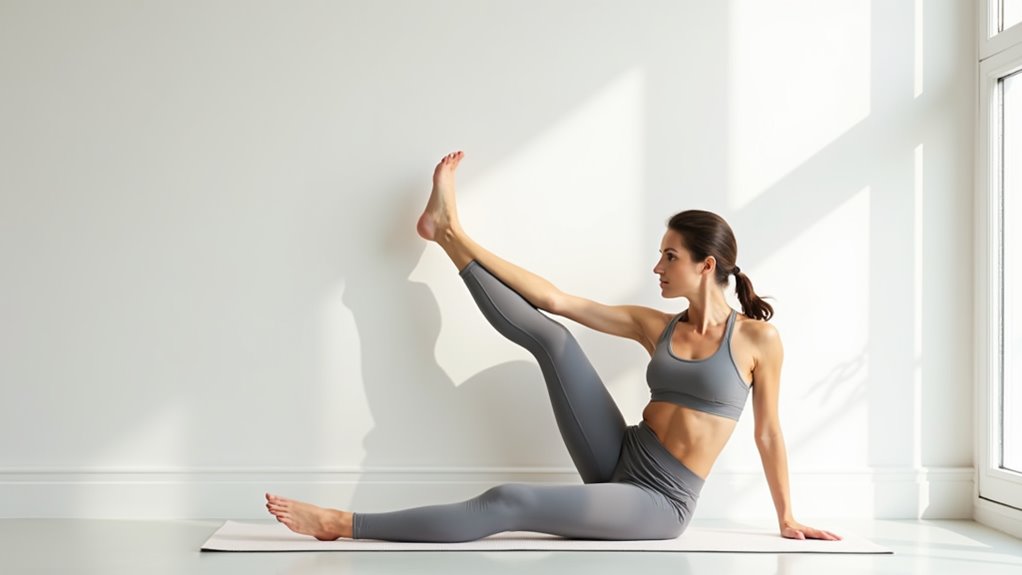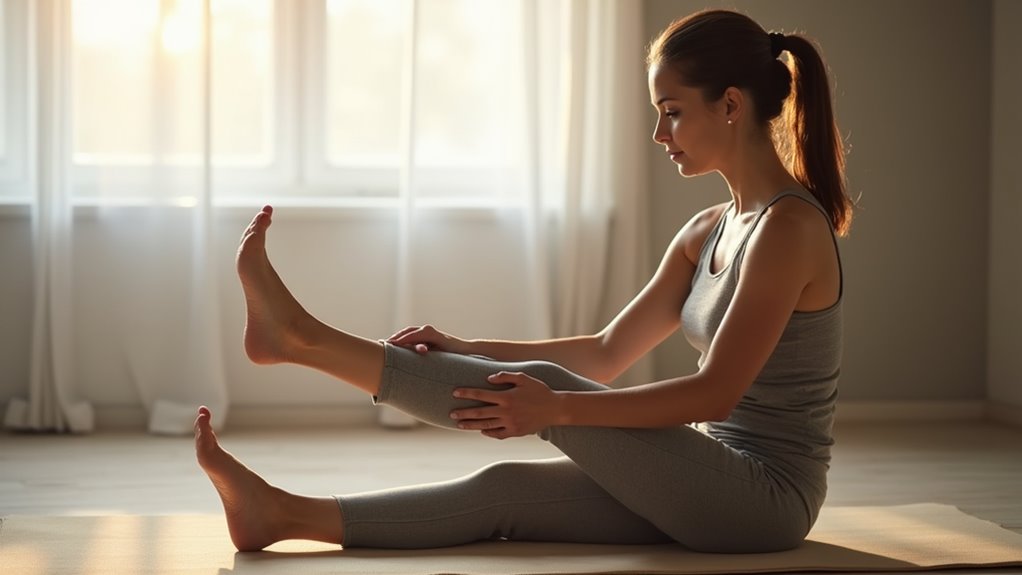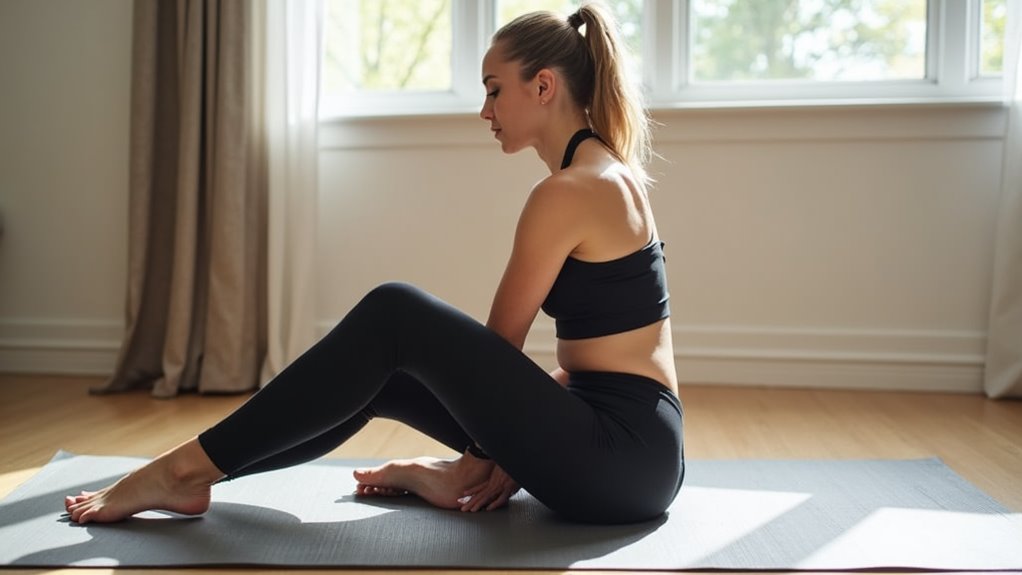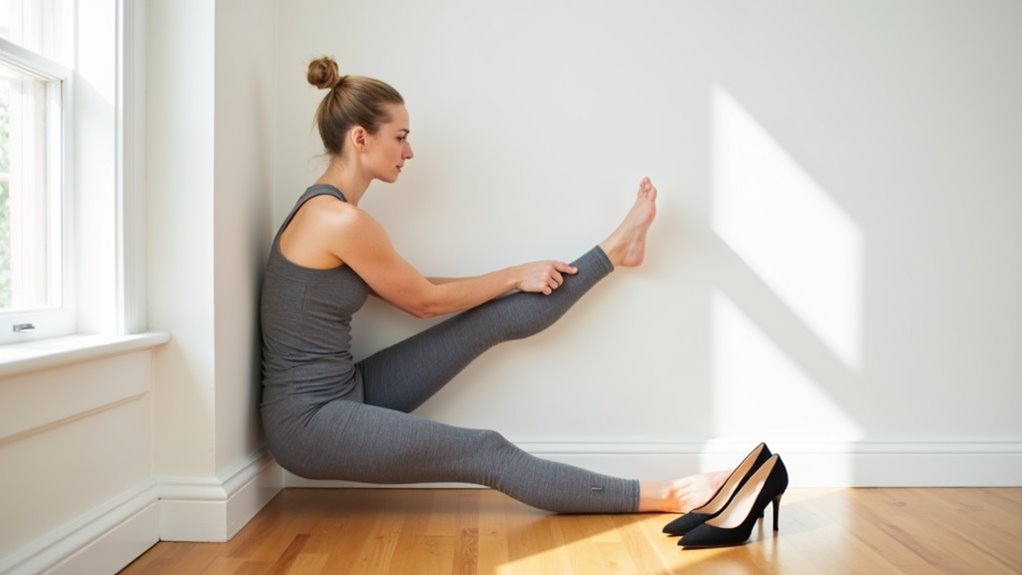There may be products. Products are independently selected by our editors. We may earn an affiliate commission from the links with no charge to you, example: as Amazon Affiliate.
If you’re a regular high heel wearer, you’ve likely experienced that familiar ache in your feet and calves. Yet, what you might not realize is that a few minutes of strategic stretching can make the difference between suffering through your day and strutting confidently in your favorite pumps. While most women focus on shoe selection and comfort inserts, it’s actually your morning and evening routines that’ll determine how well your feet handle those extra inches. The right stretches don’t just ease discomfort—they’re your secret weapon for maintaining long-term foot health and preventing chronic issues.
Key Takeaways
- Start mornings with point-and-flex foot exercises while in bed to warm up muscles before wearing heels.
- Perform wall stretches targeting calf muscles daily, keeping back heel firmly planted for maximum effectiveness.
- Use a frozen water bottle to roll under feet, reducing inflammation and massaging tired muscles.
- End each day with a 15-20 minute Epsom salt foot soak to reduce swelling and promote recovery.
- Practice ankle circles and toe yoga exercises nightly to maintain flexibility and prevent muscle shortening.
Why Daily Stretching Matters

When you regularly wear high heels, daily stretching becomes crucial for maintaining your foot and leg health. Your muscles and tendons adapt to the shortened position caused by heels, making stretching essential to counteract these effects and prevent long-term damage.
You’ll experience several key benefits from a consistent stretching routine. It enhances your flexibility, reduces muscle tightness, and improves blood flow to aid in recovery. Just 5-10 minutes of daily stretching can significantly improve your joint mobility and help maintain proper posture.
Remember to stretch after warming up your muscles, as stretching cold muscles can be harmful.
Don’t wait until you’re experiencing discomfort to start stretching. By making it part of your daily routine, you’ll protect your feet and legs while ensuring comfortable heel wear. Consider switching to eco-friendly footwear options during your non-heel wearing hours to give your feet extra relief.
Morning Stretches for Relief
A proper morning stretch routine can set the tone for comfortable heel wearing throughout your day. Start with a simple point and flex warmup while still in bed, then progress to standing stretches once you’re up.
Focus on your calves by doing wall stretches, keeping your back heel firmly planted while leaning forward.
- Belt or towel stretches target your plantar fascia, providing relief before you slip on those heels
- Rolling your foot over a frozen water bottle helps massage tired muscles and reduce inflammation
- Don’t forget your big toe stretches – they’re crucial for maintaining flexibility
These stretches are especially important if you plan to wear gold strap heels for evening events.
For best results, hold each stretch for 15-30 seconds and repeat the recommended number of times.
These targeted movements help prepare your feet and legs for a day in heels.
Evening Recovery Techniques

Taking care of your feet after wearing heels is just as important as preparing them in the morning.
Start your evening recovery with a soothing 15-20 minute foot soak in warm water mixed with Epsom salts or essential oils to reduce inflammation and soften tough skin.
Follow up with a gentle but firm massage using lotion or foot cream, paying special attention to your arches and the balls of your feet.
You can enhance this process with tools like the Naboso Neuro Ball.
For lasting relief, incorporate stretches targeting your Achilles tendon and calf muscles.
Use a half foam roller to simulate an uphill position, and try yoga poses like Virasana to improve ankle flexibility.
Don’t forget to include toe yoga and ankle circles in your routine for complete foot recovery.
For optimal results, use trusted foot products recommended by podiatrists to support your recovery routine.
Stretching Benefits for Foot Health
Regular stretching offers countless benefits for foot health, particularly for those who frequently wear high heels.
You’ll notice improved flexibility and strength in your feet, helping prevent common issues like plantar fasciitis and Achilles tendonitis. Your circulation will improve, reducing swelling and discomfort while supporting better posture and balance.
- Strengthens muscles, ligaments, and tendons to maintain natural foot movement
- Enhances blood flow to reduce fatigue and promote faster recovery
- Improves posture and balance by keeping foot muscles flexible and strong
Since your feet will walk an estimated 150,000 miles in your lifetime, regular stretching is crucial for maintaining mobility and preventing injuries.
These simple exercises can increase your range of motion while supporting daily activities without strain.
For optimal foot comfort and support, consider switching to wellness style shoes during your non-heel wearing hours.
Professional Tips and Modifications

While wearing high heels can be stylish, you’ll need smart strategies to prevent discomfort and potential injuries.
Regular Achilles tendon stretches and balance exercises are crucial for maintaining foot health. You can strengthen key muscles by incorporating leg presses and extensions, targeting the quadriceps and hip flexors that engage during heel wear.
For shoes that feel too tight, you’ve got several options to make them more comfortable.
Use shoe stretchers designed specifically for your heel type, whether they’re closed-toe pumps or heeled sandals.
When working with leather shoes, try the thick sock and blow dryer method to gently expand the material.
Just be careful to adjust stretchers to your exact measurements to avoid damaging your shoes.
For maximum comfort and support throughout the day, consider adding quality heel inserts to your favorite pairs of heels.
Conclusion
You’ll find that incorporating these morning and evening stretches into your daily routine is like giving your feet a breath of fresh air. Don’t skip these essential movements – they’re your secret weapon against the strain of high heels. By committing to these simple yet effective stretches, you’re not just preventing discomfort; you’re investing in long-term foot health and walking comfort.

